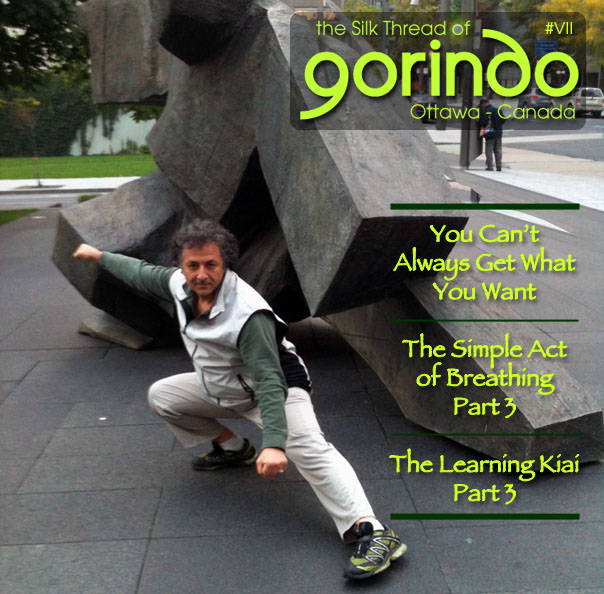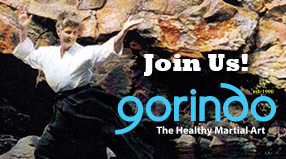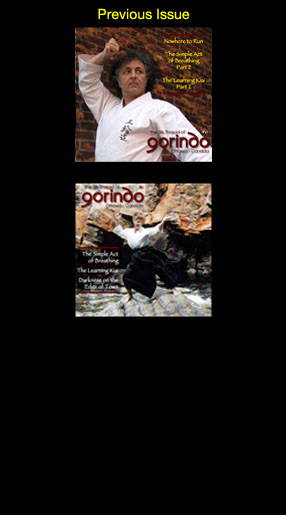
The Silk Thread of Gorindo - Ottawa - Canada
Issue VII
- The Simple Act of Breathing (Part 3)
- You Can't Always Get What You Want
Photo cover Claudio Iedwab sensei in Montreal, Sept 2010, by Roxanne Standefer
The Learning Kiai (Part 3)
< read Part 2 (previous issue)

Advanced level students recognize that one of the best ways to learn more themselves is to teach others. This is a fundamental tradition of the martial arts and a keystone of the learning methodology. Not only is it extremely rewarding and satisfying and critically important for the functioning of the dojo; it allows the senior student to look at the training from a fresh perspective, analyze questions that he might never have thought of posing himself, revisit the basics, and improve the accuracy of his own technique in demonstration. Most importantly though, he finds out what he does not know and where his understanding is weak, unclear or perhaps incorrect.
Carrying on with an attitude that he has nothing more to learn, or that he has mastered that which he knows, is the death knell for the martial artist. No matter what his skill level, the practitioner with this condition will have more fear of showing mistakes than the white belt, and as a result his progress will stop. His interest will stagnate, and all the time, effort and sweat equity put into the training will be wasted. This can happen to students who have not embraced nyuanshin, and for whatever reasons, have not come to terms with their strengths and weaknesses in an honest way.
The beginner and expert must exercise patience and maturity, and find enjoyment in their day-to-day progress. This is another area where the traditional teaching of Zen and the Tao have relevance to the martial arts student. These philosophies can provide encouragement and support on a mental and spiritual level for some very physical challenges. The Learning Kiai has many aspects to it. Some are obvious and can be called upon readily, and others are more subtle and elusive. Part of the role of the teacher is to remind you of those elements you know, and awaken you to the ones you don’t yet employ. As we have discussed, having a positive and receptive attitude is one of the first and most important.
The role of the teacher is very important in the martial arts. He or she will guide the student through simple exercises that will shape the mind and body of the beginner and help him or her discover their connection. Many of the traditions of the martial arts, which can appear on the surface to be merely cultural, are in fact basic exercises for the mind. Leaving ones’ shoes at the door, carefully positioned for easy exit, represents both the shedding of the days concerns and the state of readiness that is a characteristic of the martial artist. The experienced teacher can read somebody’s attitude by the way that his or her shoes are positioned outside of the training area. The rituals of tying the uniform or gi and the precise configuration of the knot of the belt, helps the student calm the mind and focus on the present, in preparation for the level of concentration needed in the class. There are many such examples.
Finding a good teacher and a school in which the student will feel comfortable training, is an element of the journey itself. It takes a little time and research to discover who is teaching in the community and what styles and approaches are being offered. There is a saying, that it does not matter which of the martial arts you study as long as you have a good teacher. This is generally true if the school follows a well-rounded curriculum inspired by the Do and is not just teaching fighting techniques, or is overly obsessed with competition. This is not to say that these other schools are bad, especially if they are honest about what they are offering and the quality of instruction is good. The point here is that in order to benefit from all that the martial arts have to offer, particularly the mind and body connection; the health and fitness roots; and the self-defense prime directive; there must be an acceptance of the art in martial art, and the philosophical and ethical underpinnings of its teachings.
The student must examine his motivations and expectations when searching for a school and a teacher. As we have said, this is an important aspect of the Learning Kiai and is not just something that occurs at the beginning of one’s martial arts career. Circumstances will usually dictate that there will be more than one teacher to have an influence on the student, and this is a good thing. Different perspectives, attitudes, and approaches are of benefit as long as there is a balance between being open to other ideas, and a commitment to one path for sufficient time to actually see where it is leading. It is easy to switch loyalties when the going gets a little rough, but one can miss the whole purpose of the journey. The martial artist learns to overcome obstacles with the knowledge already gained and some gentle guidance from those who have gone before.
The mind needs to be clear in these occasions and the heart must be willing to have some faith in the experience and goodwill of the teacher. Their ability to win championships or defeat the enemy does not always mean that they can be the most help to you in your own experiences in the martial arts. The student must be honest with himself, his fellow students and his teacher, and accept that he will change and grow as a result of his participation. Martial arts have always been just as much about building character as building strength and speed in the body.
Excerpt from “Martial Arts Mind & Body” by Claudio Iedwab & Roxanne Standefer. See also their e-books available at askSensei.com >>
Illustration by © Claudio Iedwab
- The Simple Act of Breathing (Part 3)
- You Can't Always Get What You Want
« Click the Subscribe link on the left




